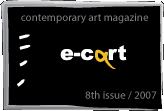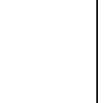Attila Tordai-S. in conversation with Mircea Cantor and Ion Grigorescu
A.T.-S. From the manner it is conceived, we can state that the Studio Protokoll exhibition raises the question of gift giving. I think that, at least at the level of statements, in a welfare society, most people think that giving and receiving gifts is a positive thing, thus an activity to be practiced. And if we think more of it, it is practiced with a certain frequency. Most of the time, children are given presents, as gift giving also has an existential side: since they can’t (and don’t have the legal right) to engage in relations of interest, based on economic services, children depend on the benevolence and support of the parents, of the grownups and of the responsible institutions. But, beyond these considerations, what is this exhibition after?
I.G. First of all, this exhibition features two people of very different ages, who could be taken for an old man and a child. The young man said “December’s coming!” as if he would have said “what present will I receive?”. But, from a certain age, you don’t receive gifts anymore. What can we do? We cannot give more than you receive in the family, because, strange as it is, presenting someone with a gift equals with marketing: I ask myself what may be attractive, what impossible wishes may I grant, what would people appreciate? But does the artist wish to astonish, is there anybody interested in our art?
Finally, the gallery manager stands between the public and the artist; maybe he knows something about the buyer who is keen for our products. In fact, I think that we succumbed to reality: at the Gulbenkian Foundation, we were able to exhibit objects with a very high production cost, almost inaccessible. Now it’s all the way around: no financial performance! No hip equipments or projectors to astonish the apprentices. At the same time, a programmed disappointment for the gallery managers (who try to take advantage): let the objects be small, to be looked after within the vast space!
This doesn’t mean they are not supposed to be liked or us not behaving ourselves, on the contrary. We remembered the things we wished for: a roller carrier. I once climbed a wall to a yard where I found labels from the medicine factory; there were nice letters, incomprehensible names. After 30 years, my father-in-law, an emigrant to Germany, presented me, in a plain age of terror, a mini-printer with rubber letters, for making stamps.
I decided to offer a definition for the exhibition “present”: it is something I make for me, then give away; let somebody else, anybody take it. This has an increased implication: to have the power to give away something that is mine, with no other advantage for the gallery manager than hiding it someplace for himself, knowing the stake. But may we presuppose a general holding back? They are used, but not taken; and maybe a list of the future owners may be drawn. Finally, everybody must learn how to behave: the producers, the owners, the buyers. Let us think – it’s December – about being better, nicer.
A.T.-S. There is no gallery manager at Studio Protokoll, as the studio is a place free from commercialization, and this aspect is even disapproved. I wonder if we really have to succumb to reality. I think that finally each of us has to decide freely about how to regard art: to sent the work to the market or to send it to the political field; does he want it to become a private or a public space?
I.G. Every exhibitor could torment you with the costs, the requirements and you could answer him back the same way; I think it’s hard to find that kind of artist – it may take a long time, years…
Regarding the duo with Mircea, here’s how the things are: he came with the proposition of doing something together. He is exhibiting several times a year, and I took the precaution of not wasting myself anymore, but looking after my last projects, of which the galleries don’t even ask, for them, I belong to the past: because what I have exhibited is recurrent. So, since Mircea tried me, I thought about a topic concerning “what is beautiful (now)?”, because there is a great distance between us. Maybe it could have been a debate. Now I see him scanning his childhood and finding a documentation about it, which he was carefully enough to preserve. He also has a child, I myself, after various events, had three and their birth meant an exemption from that never ending socialism. So here we are, the topic of “succumbing” to reality is returning. Once socialism over, I thought that there was no point dealing with politics anymore, but with myself.
The purpose of art is widely approached by the many artists, and it is also related to the condition of authenticity. But above them, there are the ministries, which have a programme, a strategy and funds, which they use to tally exhibitions with standard topics: “post-communism”, “the Balkans”, “identities”, “minorities”, which grant scholarships and form cultural “activists” who are in the artist’s hair now and curate exhibitions.
My part, namely what I am going to do next, consists in revisiting that “chaos” Mircea was also talking about; from my point of view, the text books and negative strips are, as Andreas Kreuger would say, my own history.
Indeed, this exhibition is a detour from normality, it’s just a Sunday break; I don’t know if we could impose such a programme somewhere else. I remember an Italian journalist calling me “unclean” ["trascurato"]; I believe, however, that we are being “more ourselves”.
A.T.-S. Mircea, you came with the idea of exhibiting together. And, more precisely, of doing something about the presents and, at the same time, something to involve children. Why?
M.C. Making an exhibition with Ion Grigorescu about toys, gifts, Christmas already seems to me a proposition meant to awake the interest. But to whom or why, remains to be seen. The art works, as we all know, awake the interest according to the name, the context they are presented in, the way they are reflected by the media, etc. And then we have the opposite – generally speaking, the passivity or the apathy of the public or the superficiality implied by “the habit of going to openings and exhibitions”. The routine. Maybe this is the most interesting aspect: how to overcome routine, in this context – as an artist, as a gallery manager, as a visitor. And then you use art-ifices. Maybe the fir tree adorned by mother is far more artistic(ally charged) than what I am about to present in the exhibition. Talking about this Christmas exhibition, the toys which come to my mind are maybe more artistic, also because this is the period when they are in the foreground. I had some exchanges of ideas with Ion Grigorescu about what kind of toys to exhibit, for whom, why, etc.
First of all, it’s certain that we are reaching a point where the public may be more interested and diverse, and, secondly, we, as artists, are climbing down the pedestal of the “unfathomable” ones, in order to meet some place in between. For each of us, the Christmas, the fir tree, the toys are very poignant realities, subjectively charged with all kinds of memories. This refers to a common language, by which we can communicate even if we speak different languages.
A.T.-S. The instrument you use when approaching this common project, this public event, seems to be the revisiting. You revisited the past and confronted it to the chaos or you let the childhood return from the past.
You have mentioned, Mr. Grigorescu, the possibility of a debate, which seems, however, not to exist. Maybe there are too many realities which do not communicate? Mircea said that the fir tree, the Christmas or the toys are something like a language one could use to dialogize. What should this dialogue be about? What could be the actuality of the exhibition?
I.G. The past is very rich because it is chaotic; if we would organize it, we would deplete and exhaust it.
Anyway, it doesn’t let itself be exhausted… I will quote from Freud (The Wolf Man): “the pile of filth [merda-rie], left behind by the burglars at the crime scene, seems to represent both the mockery and the reward”.
Here, in Bucharest, the city hall, using money from European Drinks, brought the tallest and brushiest fir tree I’ve ever seen; it is placed on the grass, next to the National Theatre, an will be watched over by three guards. People will smile… Further on, there is a fir tree made of lights, on the intersection clock – it was lighted several days ago, and it was announced in the press. Soon, this fir tree will suffocate us without us feeling, in fact, that the sponsors of these actions presented us with a gift, we, that category of people that has seen a lot in life; I think that those amazed and touched by the grandiloquent gestures will be the by-passers, those which can still be blinded by abundance. I avoid calling them other names… No matter what we would talk about, there will be others to outdo us, to inflate it to the breaking point. We are between the hammer and the anvil; as I said: some mock by exaggeration, others mock because it’s trendy to be cynical.
I don’t think that the exhibition will be a dialogue (about something), it will be something brute, like a simple conversation: hey, mister, what are you doing with that thing, will you give it to me? – well, mister, everything’s for share! But what kind of gifts are these, they are just too pauper! But you know the saying about the burglars who leave some filth as a reward? That’s how language is, ambivalent! And, moreover, we are not burglars.
Translated by Alex Moldovan




















